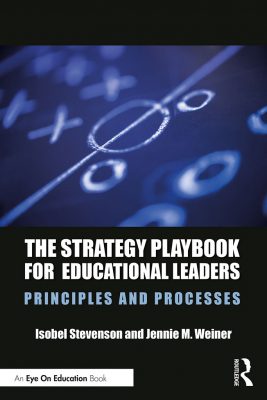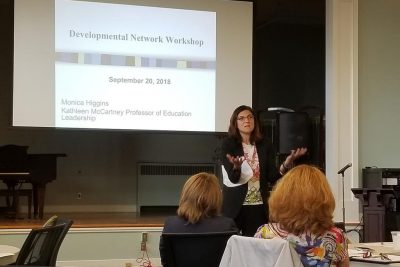Editor’s Note: The following is an excerpt from Chapter 1 of The Strategy Playbook for Educational Leaders: Principles and Processes (Routledge, 2020), a new book co-authored by Neag School Associate Professor Jennie Weiner and her colleague Isobel Stevenson, director at the Connecticut Center for School Change.
The volume is a how-to resource designed for superintendents, central office staff, principals, and teacher leaders that looks to “provide leaders with a concrete framework for a strategic improvement plan, helping educators link the ‘principles’ to ‘processes’ of planning.” This excerpt has been published here with the publisher’s permission.
From The Strategy Playbook for Educational Leaders
 Perhaps you remember what school improvement planning was like in the 1990s, when total quality management (TQM) and site-based decision-making were in vogue. As with many innovations, sometimes a lot is lost in translation between the idea and its implementation. In the case of TQM, the result was often a lot of focus on goals that were unrealistic or did not promote equity, and on interventions that tended to be more oriented toward compliance than continuous improvement.
Perhaps you remember what school improvement planning was like in the 1990s, when total quality management (TQM) and site-based decision-making were in vogue. As with many innovations, sometimes a lot is lost in translation between the idea and its implementation. In the case of TQM, the result was often a lot of focus on goals that were unrealistic or did not promote equity, and on interventions that tended to be more oriented toward compliance than continuous improvement.
First, there was a heavy emphasis on goals. Outcomes were supposed to be specific, measurable, attainable, realistic, and timely (SMART), and a lot of time was spent making sure this occurred. It was easy to get the impression that the goals themselves were what mattered — if you chose the right goal, you would be more likely to meet it. It was as if the goals themselves had the power to produce good outcomes, regardless of the resources available to enact them. As a result, those in schools and at the central office spent a lot of time perseverating over the goals and their semantics.
We have both sat in very long meetings in which teams spent hours coming up with the “right goal.” For example, there were the many high school teams who struggled to agree on the right graduation goal. They asked, “Should we make the goal that 100% of incoming freshmen graduate in four years, even if we don’t think it’s realistic? Because if we don’t, does that mean we are saying that we don’t care about all kids? Plus the goal really is that 100% graduate. But if we do say 100% and we don’t meet that goal, will we get in trouble? Should we say six years? How about five?” When these are the questions, there are no right answers.
It was easy to get the impression that the goals themselves were what mattered — if you chose the right goal, you would be more likely to meet it. It was as if the goals themselves had the power to produce good outcomes, regardless of the resources available to enact them.
It often felt that it was important to choose BHAGs — big, hairy, and audacious goals — regardless of whether they were rooted in any real evidence or grounded in goals of equity and inclusion. The format of the Adequate Yearly Progress goals associated with No Child Left Behind was an example of this orientation. Not choosing BHAGs became an indicator that you weren’t serious about improvement, or that you weren’t willing to work hard enough to reach them. In the worst cases, it was thought that merely creating a BHAG was a predictor of reaching it.
The result of these struggles over goals was the continued piling on of consequences for underperforming schools, the demoralization of the educator workforce, and — important for our discussion — a sense that planning was inconsequential or even foolhardy. It turns out not to be true that an ambitious goal inevitably leads to an amazing result.
It turns out not to be true that an ambitious goal inevitably leads to an amazing result.
It was based on these often unrealistic and problematic goals that school improvement teams built their plans. Frequently presented as a list of tasks to be completed or a template to be filled out, these plans tended to be procedural in nature (first, second, third, etc.) and focused on things like when committees would meet to talk about the goal, who was going to do what, what training would be provided, and the date by which all this was going to be accomplished. Each goal had its own comprehensive list of action steps, with some plans growing unmanageably long. Isobel confesses to writing one as a principal that was more than 70 pages, and Jennie remembers reading a district plan that was over 270 pages!

To help streamline the process and hold schools accountable for creating and implementing their plans, districts and state departments of education often created elaborate templates for how they wanted school improvement plans written. In some cases, states even created standard templates required of all schools and districts. Often, these were well-intentioned attempts to minimize the number of documents that schools had to submit. For example, a school might no longer have to submit a separate Title I plan as there was a universal improvement plan that covered everything. Sometimes the templates, either district- or state-mandated, tried to force the school to follow a certain process to generate its plans. The template could include, for example, questions about what data were used to generate the plan, what the analysis of these data revealed, and how community stakeholders were engaged to decide on the appropriate goals.
And yet, despite encompassing many rules in what appeared to be an attempt to institutionalize data-based decision-making and create meaningful change, processes to create the plan, and the plans themselves, infrequently included deep discussion about equity or changing practice — the primary process for producing results in schools. Moreover, these plans rarely created the impression that teachers were supposed to teach differently or reflect on how they thought about and understood their relationship to their students.
Perhaps it is the case that in your school or district you participate in an annual cycle of goal setting … with the sinking feeling that none of it will amount to real change.
This is strange, when you think about it, as the organizational consultant who is frequently cited as the instigator of data-driven planning, W. Edwards Deming (1986), was all about process. His book Out of the Crisis is a kind of manifesto about how generations of business owners had not paid enough attention to the processes being used in generating their results. Some of his ideas were translated into familiar slogans: “If you do what you’ve always done, you’ll get what you’ve always gotten,” “The definition of madness is doing the same thing over and over and expecting a different result,” and “Every system is perfectly designed to achieve the results it gets.”
Perhaps it is the case that in your school or district you participate in an annual cycle of goal setting, filling out templates to create a plan, submission of the plan for feedback and approval, and working with committees, departments, or grade-level teams to implement the plan—all with the sinking feeling that none of it will amount to real change. Perhaps you’re frustrated as the plan you created seems to have no life outside its place on the shelf. Perhaps you’re looking for suggestions for how to give the process more meaning and traction.
In that case, you’re in the right place, because that’s exactly what we’re going to do in this book.
Learn more about The Strategy Playbook for Educational Leaders.
 Facebook
Facebook
 Twitter
Twitter
 LinkedIn
LinkedIn
